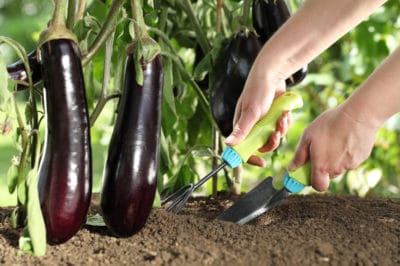Feeding the Seedling
Fertilizers offer several choices — liquid or granulated, organic or synthetic. Liquid fertilizers cost more than granulated, but granulated fertilizers must be worked into the soil to a depth of 6″ to create a supply of nutrients as the eggplant roots grow deeper. Once they are diluted and applied, liquid fertilizers sink in on their own. If you lack the physical ability or the time to work the fertilizer into the soil, you can still enjoy your garden by using a liquid fertilizer.
When it comes to nutrients, organic and synthetic fertilizers are equal. However, organic fertilizers receive minimal processing when compared to synthetic fertilizers. Synthetic fertilizers are created from processed chemicals. Your eggplants receive nutrients more quickly from synthetic fertilizers, but these fertilizers can have negative environmental impacts.
Organic fertilizers you can choose include:
- Well-rotted manure
- Dehydrated chicken dung
- Bat guano
- Blood meal
- Cottonseed meal
- Some name brand plant foods for vegetables such as Burpee’s Big Boy Tomato Food
Before transplanting your eggplants, treat the area with a liquid fertilizer or, for every 100 square foot of garden area, work 2 to 4 pounds of a complete 10-10-10 fertilizer into the soil to a depth of 6″. If you prefer organic fertilizers, cover your garden with 2″ to 3″ of compost or well-rotted manure, and then work the compost or manure into the soil.
As you transplant your eggplants, you can dissolve 2 tablespoons of 5-10-10 complete fertilizer in a gallon of water and pour 1 cup of the solution into the hole for each plant or mix a handful of compost with some soil and place it into the holes for your plants. To keep the roots from being burned, cover the fertilizer or compost with 1″ to 2″ of soil before moving the plants into the holes.
Feeding the Hard-Working, Productive Plant
When the first tiny eggplants begin to appear, side-dress the plants by creating a shallow trench in a circle 6″ to 8″ in diameter around the plants, placing a complete 10-20-20 or 10-30-10 fertilizer in the trench, and then covering the fertilizer. Alternately, you can spread the fertilizer in a circle around the plant, and then cover the fertilizer with soil or carefully work the fertilizer into the soil. Avoid working too close to the plants where you might damage the roots.
Side-dress the plants again when the first eggplants are ready to harvest and then every four to six weeks after that during the growing season. Apply 1 to 1 1/2 pounds for every 100 square foot of garden space. Water your eggplants after each application. Provide enough water to carry the fertilizer down to the plant roots.
If you notice that your plants are producing only a few, small eggplants but thick foliage, it’s an indication that the plants are receiving an excessive level of nitrogen. In that case, change the complete fertilizer you are using to one with less nitrogen content. The level of nitrogen is represented by the first of the three numbers on the labels of complete fertilizers.
Feeding the Potted Plant
If you live in a condominium or an apartment, you can grow varieties of eggplants such as Burpee’s Millionaire Hybrid and Blue Marble Hybrid in containers. However, because the plants have less soil from which to draw nutrients and because watering the plants carries soil and nutrients out of the container, container grown eggplants require applications of a soluble 15-30-15 or 20-20-20 fertilizer every one to two weeks.
Feeding your eggplants a healthy supply of nutrients ensures they will provide you with a healthy supply of delicious eggplants.
